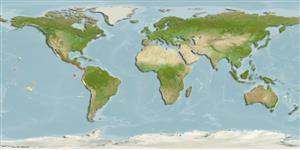Teleostei (teleosts) >
Pleuronectiformes (Flatfishes) >
Cynoglossidae (Tonguefishes) > Symphurinae
Etymology: Symphurus: Greek, syn, symphysis = grown together + Greek, oura = tail (Ref. 45335).
Environment: milieu / climate zone / depth range / distribution range
Ecology
Marine; demersal; depth range 18 - 317 m (Ref. 9294), usually 60 - 110 m (Ref. 9294). Tropical; 25°N -
Eastern Pacific: Mexico to Peru.
Size / Weight / Age
Maturity: Lm ? range ? - ? cm
Max length : 16.2 cm SL male/unsexed; (Ref. 9294); common length : 14.0 cm SL male/unsexed; (Ref. 9294)
Dorsal spines (total): 0; Dorsal soft rays (total): 105 - 114; Anal spines: 0; Anal soft rays: 91 - 98; Vertebrae: 57 - 61. Body flat, somewhat elongated, with an oval anterior border; both eyes on left side of head; dorsal fin with 105 to 114 rays, anal fin with 91 to 98 rays; caudal fin with 12 rays; body chocolate brown, usually with 9 to 11 indistinct transverse bars; lower half of operculum on the eyed side with a small stain; posterior side of dorsal and anal fins dark, rectangular stains (Ref. 55763).
Probably caught as a bycatch in trawl fisheries (Ref. 9294).
Life cycle and mating behavior
Maturities | Reproduction | Spawnings | Egg(s) | Fecundities | Larvae
Munroe, T.A., F. Krupp and M. Schneider, 1995. Cynoglossidae. Lenguas, lenguetas. p. 1039-1059. In W. Fischer, F. Krupp, W. Schneider, C. Sommer, K.E. Carpenter and V. Niem (eds.) Guia FAO para Identification de Especies para lo Fines de la Pesca. Pacifico Centro-Oriental. 3 Vols. FAO, Rome. (Ref. 9294)
IUCN Red List Status (Ref. 130435)
Threat to humans
Harmless
Human uses
Fisheries: minor commercial
Tools
Special reports
Download XML
Internet sources
Estimates based on models
Preferred temperature (Ref.
123201): 14.8 - 21.5, mean 15.9 °C (based on 27 cells).
Phylogenetic diversity index (Ref.
82804): PD
50 = 0.5000 [Uniqueness, from 0.5 = low to 2.0 = high].
Bayesian length-weight: a=0.01445 (0.00647 - 0.03228), b=3.05 (2.85 - 3.25), in cm total length, based on LWR estimates for this (Sub)family-body shape (Ref.
93245).
Trophic level (Ref.
69278): 3.3 ±0.4 se; based on size and trophs of closest relatives
Resilience (Ref.
120179): High, minimum population doubling time less than 15 months (Preliminary K or Fecundity.).
Fishing Vulnerability (Ref.
59153): Low vulnerability (10 of 100).
